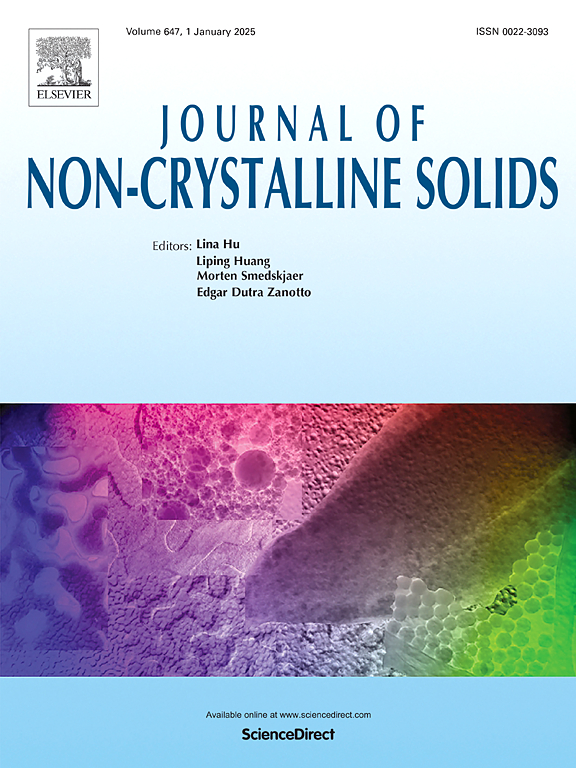A holistic approach to Cr₂O₃-doped lithium lead borosilicate glasses: probing thermal stability, optical emissions, and gamma shielding
IF 3.5
3区 材料科学
Q1 MATERIALS SCIENCE, CERAMICS
引用次数: 0
Abstract
A series of chromium oxide (Cr₂O₃)-doped lithium lead borosilicate glasses with the nominal composition (20−x)Li2O+5PbO+15B2O3+60SiO2+xCr2O3 (where x = 0.00–0.5 mol%) were successfully synthesized via the conventional melt-quench technique. The structural, morphological, thermal, optical, and radiation shielding characteristics of these glasses were investigated using various advanced characterization techniques. X-ray diffraction (XRD) analysis confirmed the amorphous nature of all prepared samples, evidenced by the absence of sharp diffraction peaks. The broad humps observed in the XRD patterns were consistent with a disordered glass network, which remained intact upon Cr₂O₃ doping up to 0.50 mol%. Scanning electron microscopy (SEM) images revealed a homogeneous and dense glassy microstructure, with minor surface irregularities that slightly increased with higher Cr₂O₃ content, suggesting local compositional variation or microphase separation. Energy-dispersive X-ray spectroscopy (EDS) analysis validated the elemental composition and confirmed the successful incorporation of chromium into the glass matrix. Fourier-transform infrared spectroscopy (FTIR) studies indicated the presence of Si–O–Si, B–O–B, and B–O–Si linkages, with additional bands attributed to non-bridging oxygen (NBOs) and Cr–O vibrations appearing in the 550–700 cm⁻¹ region for doped samples. The increase in Cr₂O₃ concentration led to a slight shift and broadening of these bands, implying structural modifications in the glass network, likely due to the conversion of BO₃ to BO₄ units and increased NBO content. Raman spectroscopy further supported these findings by revealing a systematic evolution of vibrational modes associated with BO₃/BO₄ units and silicate groups. The progressive intensity changes in Cr-related modes suggest a shift in chromium coordination and interaction with the glass network. Differential thermal analysis (DTA) showed a gradual increase in the glass transition temperature (Tg) with Cr₂O₃ addition, indicative of enhanced network rigidity. However, at higher doping levels (≥0.3 mol%), a slight reduction in thermal stability was observed, potentially due to the clustering of Cr ions or partial crystallization tendencies. Radiation shielding properties were evaluated by calculating parameters such as linear attenuation coefficient (LAC), mass attenuation coefficient (MAC), and half-value layer (HVL). The results demonstrated an improvement in gamma-ray attenuation ability with increasing Cr₂O₃ concentration, primarily due to the higher atomic number and density of Cr ions, which enhance photon interaction probabilities. Electron paramagnetic resonance (EPR) spectra confirmed the presence of Cr³⁺ ions in octahedral symmetry, with a prominent resonance signal around g ≈ 1.97. The increasing intensity and narrowing of the resonance lines with Cr₂O₃ content point to stronger Cr³⁺–Cr³⁺ dipolar interactions and possible clustering effects at higher doping levels. Optical absorption spectra exhibited characteristic Cr³⁺ bands, particularly in the UV–Vis region, attributed to electronic transitions such as 4A2g→4T2g and 4A2g→4T1g. The optical band gap energy (Eₒₚₜ) was found to decrease with increasing Cr₂O₃ content, indicating an increase in localized states and the formation of NBOs within the glass matrix. Photoluminescence (PL) spectra displayed broad emission bands in the red–near infrared region, centered around 700–750 nm, corresponding to the 4T2g→4A2g transitions of Cr³⁺ ions. The emission intensity initially increased with Cr doping up to 0.2 mol% due to efficient energy transfer and optimum dispersion of Cr³⁺ ions, followed by quenching at higher concentrations due to concentration quenching and cross-relaxation effects. In summary, Cr₂O₃ doping induces significant structural rearrangements and enhances the optical and radiation shielding capabilities of Li₂O–PbO–B₂O₃–SiO₂ glasses. The sample with 0.2 mol% Cr₂O₃ (LiCr-0.25) exhibited the most balanced combination of thermal stability, photoluminescence efficiency, and shielding performance, making it a promising candidate for optoelectronic and radiation protection applications.
Cr₂O₃掺杂硼硅酸盐锂铅玻璃的整体方法:探测热稳定性,光学发射和伽马屏蔽
采用常规熔融淬火技术,成功合成了标称成分为(20−x)Li2O+5PbO+15B2O3+60SiO2+xCr2O3(其中x = 0.000 ~ 0.5 mol%)的氧化铬(Cr₂O₃)掺杂硼硅酸盐锂铅玻璃。利用各种先进的表征技术研究了这些玻璃的结构、形态、热、光学和辐射屏蔽特性。x射线衍射(XRD)分析证实了所有制备样品的无定形性质,证明没有尖锐的衍射峰。在XRD图中观察到的宽峰与无序的玻璃网络一致,当Cr₂O₃掺杂0.50 mol%时,玻璃网络保持完整。扫描电镜(SEM)图像显示了均匀而致密的玻璃状微观结构,随着Cr₂O₃含量的增加,表面不规则性轻微增加,表明局部成分变化或微相分离。能量色散x射线光谱(EDS)分析证实了元素组成,并证实铬成功掺入到玻璃基体中。傅里叶变换红外光谱(FTIR)研究表明存在Si-O-Si, B-O-B和B-O-Si键,在掺杂样品的550-700 cm - 700 cm区域出现了非桥氧(NBOs)和Cr-O振动的额外波段。Cr₂O₃浓度的增加导致这些能带的轻微移动和拓宽,这意味着玻璃网络中的结构改变,可能是由于BO₃向BO₄单位的转化和NBO含量的增加。拉曼光谱通过揭示与BO₃/BO₄单元和硅酸盐基团相关的振动模式的系统演化进一步支持了这些发现。铬相关模式的逐渐强度变化表明铬与玻璃网络的配位和相互作用发生了转变。差热分析(DTA)表明,随着Cr₂O₃的加入,玻璃化转变温度(Tg)逐渐升高,表明网络刚度增强。然而,在较高的掺杂水平(≥0.3 mol%)下,观察到热稳定性略有下降,可能是由于Cr离子的聚集或部分结晶倾向。通过计算线性衰减系数(LAC)、质量衰减系数(MAC)和半值层(HVL)等参数来评价辐射屏蔽性能。结果表明,随着Cr₂O₃浓度的增加,伽马射线衰减能力有所提高,这主要是由于Cr离子的原子序数和密度增加,从而提高了光子相互作用的概率。电子顺磁共振(EPR)谱证实了Cr³+呈八面体对称存在,在g≈1.97附近有一个突出的共振信号。随着Cr₂O₃含量的增加,共振线的强度增加和变窄表明Cr³+ -Cr³+偶极相互作用更强,并且在更高掺杂水平下可能产生聚类效应。光学吸收光谱显示出Cr³+的特征带,特别是在UV-Vis区,归因于4A2g→4T2 g和4A2g→4T1g等电子跃迁。光学带隙能(Eₒₚ)随着Cr₂O₃含量的增加而降低,表明局域态的增加和玻璃基体内nbo的形成。光致发光(PL)光谱在红-近红外区显示出较宽的发射带,以700-750 nm为中心,对应于Cr³⁺的4T2 g→4A2 g跃迁。Cr +掺杂到0.2 mol%时,由于Cr +的高效能量传递和最佳分散,发射强度开始增加,随后由于浓度猝灭和交叉弛豫效应,发射强度在较高浓度下猝灭。综上所述,Cr₂O₃掺杂引起了明显的结构重排,增强了Li₂O - pbo - b₂O₃-SiO₂玻璃的光学和辐射屏蔽能力。含有0.2 mol% Cr₂O₃(LiCr-0.25)的样品在热稳定性、光致发光效率和屏蔽性能方面表现出最平衡的组合,使其成为光电和辐射防护应用的有希望的候选材料。
本文章由计算机程序翻译,如有差异,请以英文原文为准。
求助全文
约1分钟内获得全文
求助全文
来源期刊

Journal of Non-crystalline Solids
工程技术-材料科学:硅酸盐
CiteScore
6.50
自引率
11.40%
发文量
576
审稿时长
35 days
期刊介绍:
The Journal of Non-Crystalline Solids publishes review articles, research papers, and Letters to the Editor on amorphous and glassy materials, including inorganic, organic, polymeric, hybrid and metallic systems. Papers on partially glassy materials, such as glass-ceramics and glass-matrix composites, and papers involving the liquid state are also included in so far as the properties of the liquid are relevant for the formation of the solid.
In all cases the papers must demonstrate both novelty and importance to the field, by way of significant advances in understanding or application of non-crystalline solids; in the case of Letters, a compelling case must also be made for expedited handling.
 求助内容:
求助内容: 应助结果提醒方式:
应助结果提醒方式:


